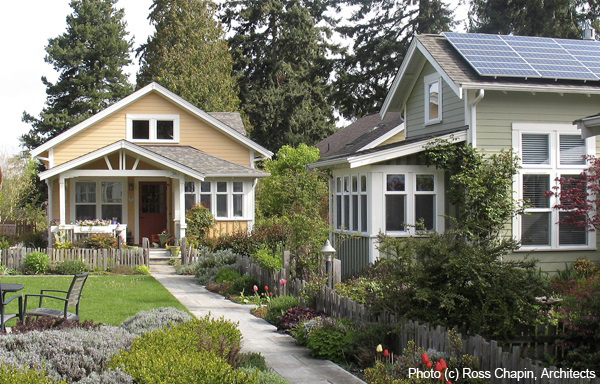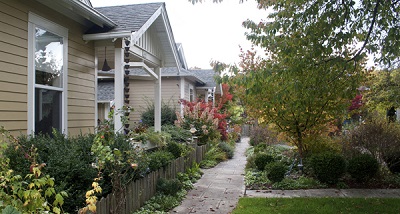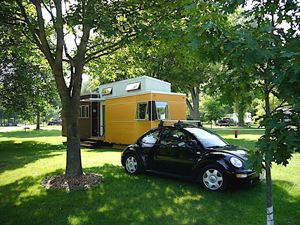Tiny Houses, Tiny Neighborhoods
By Wendy Priesnitz

The small houses in the Greenwood Avenue Cottages Pocket Neighborhood in Shoreline, Washington. Architect: Ross Chapin, Architects; Developer: The Cottage Company. Photo (c) Ross Chapin, Architects |
Back in 2005, when I first wrote in this magazine about tiny houses, they were a novelty for many people, and an extension of the pursuit of a minimalist lifestyle for others. But that was before the recession and the escalation of concern about climate change spiked interest in the idea of reducing one’s costs and one’s possessions (and therefore one’s ecological footprint). So a full-fledged tiny house movement has developed in recent years, and it continues to grow stealthily. There are an increasing number of people attending workshops and open houses, and visiting blogs, in order to learn about living in and building tiny houses. And there is no lack of alluring examples to be found online.
Like any disruption of the status quo, there are barriers to building very small houses, including building codes, zoning bylaws, and financing constraints. Some people are working on those issues, but in most cases they are working around them. One tactic often used is to build the house on a steel frame with wheels, mimicking an RV. However, some people wonder why you wouldn’t just live in a real RV or boat, instead. Then there are those who think that, in colder climates, the ubiquitous tiny condo spaces are preferable than standalone tiny houses, since they use resources more efficiently.
One interesting development accompanying the increasing interest in small and tiny houses is a return to village-scale living. We are, I think, at the beginning of a new movement that will see tiny communities of tiny houses popping up. The ones currently in place or being planned include an urban demonstration project designed to advocate for tiny houses, planned communities designed to accommodate the homeless, a few attempts at developing what are legally RV parks, a boutique “hotel” that’s a collection of four tiny houses on wheels, and more upmarket developments of cottage-style housing – small but not tiny – designed to fit within existing regulations. There are also some existing eco-villages that allow tiny houses to be built.
When you’re living in a small space, it’s nice to get outside and important to know (and cooperate with) your neighbors. So grouping tiny houses into neighborhoods or villages makes sense, allowing for shared amenities and central gathering spaces. Here are some examples of what's currently happening on that front.
Boneyard Studios

The four tiny houses of Boneyard Studios on a small infill lot in Washington, D.C. are a demo project. Photo (c) Jay Austin |
Boneyard Studios, founded in 2012 in a dense, walkable, urban neighborhood in the Washington DC area, is a micro-village of four tiny houses on wheels, with the largest measuring just over two hundred square feet. The houses are situated on what was a vacant, triangular alleyway lot full of overgrown grass, broken concrete, pooling water, garbage, illegal parking, and occasional criminal activity like the dumped stolen vehicle they had to have moved.
Now, in addition to the collective’s three tiny houses and one they’re looking after for a friend, the rehabilitated lot houses a small fruit orchard, green open space, a community garden, a cistern for garden watering, and a shipping container that’s used for bike storage and a workshop.
Calling themselves Boneyard Studios, friends Brian Levy and Lee Pera (joined by Jay Austin shortly thereafter) hope to demonstrate creative urban infill; promote the benefits of tiny houses; model what a tiny house community could look like; build capacity of tiny house designers and builders; and advocate for DC zoning/code changes to allow construction and habitation of accessory dwelling units and tiny houses.
Since, under current city restrictions, the houses cannot be lived in full-time, Boneyard Studios acts as a showcase for what could be.
Tiny Houses for the Homeless
The idea that community matters is at the root of the emerging tiny village philosophy, which addresses affordable and sustainable housing at the same time. Local non-profits have embraced the idea of tiny houses grouped in a village format as a way to help the growing number of homeless or low-income people. The model is reminiscent – and somewhat based on – the self-organized tent cities that have become a common way for the homeless to provide for themselves. A group will typically acquire a piece of land with the co-operation of local government, then fundraise and construct a group of simple micro-housing structures surrounding shared, common space.
Opportunity Village in Eugene, Oregon is a transitional housing community with thirty micro-housing units for otherwise homeless individuals and couples. In Austin, Texas, Community First! Village, a program of Mobile Loaves & Fishes, is a 27-acre master-planned community that will provide affordable, sustainable housing and a supportive community for some two hundred disabled, chronically homeless people. It has been in the planning and fundraising stages for nearly ten years and breaks ground this year. There will be tiny houses, mobile homes, teepees, refurbished RVs, a three-acre community garden, a chapel, a medical facility, a workshop, a bed and breakfast, and an outdoor movie theater.
Quixote Village in Olympia, Washington is a two-acre community of 30 tiny cottages and a central community building that includes showers, laundry facilities, a shared kitchen, and social and meeting space. With the help of government grants, fundraising, a donation of municipal land and zoning changes, and support of the faith community, the village replaces a tent city housed in church parking lots. On the new site, residents hope to plant a vegetable garden and fruit trees, and to start one or more micro-enterprises that could bring in income to support the Village and its residents.
Pocket Neighborhoods

Third Street Cottages in Langley, Washington, is a cluster of eight small homes around a shared garden, and became the first "Pocket Neighborhood." Architect: Ross Chapin, Architects; Developer: The Cottage Company. Photo (c) Ross Chapin, Architects |
In 1996, architect Ross Chapin and developer Jim Soules collaborated on building the Third Street Cottages, a cluster of eight small cottages around a shared garden in Langley, Washington. The cottages were tucked off a busy street, which seemed to Ross like a pocket safely tucking away its possessions from the world outside. He began calling it a “pocket neighborhood” and the term stuck.
Third Street Cottages was the result of involvement of people on every level who paved the way: a forward-thinking state government, a pro-active planning director, an innovative architect, a sensitive developer, an enlightened banker, and a supportive community. Facing the same growth pressure as many towns across America, the City of Langley, WA (pop. 1,100) adopted the innovative “Cottage Housing Development” (CHD) zoning code provision that made these small homes possible.
The code’s aim is to preserve housing diversity, affordability, and character, and to discourage the spread of sprawl. It allows for up to double the density of detached homes in all single-family zones — providing the ground floor area is less than 700 square feet and total area including the second floor is less than 975 square feet. The cottages must also face a usable landscaped commons, and have parking screened from the street. To ensure good fit within existing neighborhoods, each project proposed is reviewed by the planning and design review boards.
Third Street Cottages was the first to utilize this innovative code. The award-winning community of eight detached cottages is located on four standard single-family lots. The homes are approximately 650 square feet, with lofts up to 200 square feet, and are conveyed as condominium ownership. The design imperatives were to provide well-defined personal space while fostering a strong sense of community.
Entry to the community is through “implied” gates into the semi-public Commons, which is a shared garden area edged with a perennial border and a low split-cedar fence. A swinging gate opens to each private yard, and a walk leads to steps, the front porch, and front door. The porch railing is at a height just right for “perching” and is adorned with flower boxes to further define a personal boundary. Within the cottages, the layering continues with active spaces in front and private spaces in back.
To ensure privacy between cottages, the houses “nest” together: the “open” side of one house – with large windows facing the side yard – faces the “closed” side of the next, which has high windows and skylights.
The first line of defense for personal security is a strong network of neighbors who know and care for one another, and the houses are situated to encourage that. They also have ample porches that extend living space and encourage interaction with neighbors in the adjacent Commons.
Parking is intentionally situated away from the cottages but screened from the street. When residents walk from car to home, they can interact with neighbors and enjoy the landscaping in the Commons, which is the locus of community. In the middle is a combination of flowers, vegetables, and lawn, while to the side is a workshop with terrace on the roof. A tool shed provides a place to store shared garden tools.
A variety of singles, couples, and small families have been attracted to these pocket neighborhoods. They, like everyone else interested in small or tiny houses and the communities they create, care about increasing their connection to community while decreasing their impact on the environment.
Bureaucratic Constraints
Regulations restricting the construction of tiny houses vary from place to place. However, it’s common that to be in compliance with building codes and therefore occupied full-time, a house must be built to a dictated minimum size, usually eight hundred square feet. (Basic principles of design state that there should be an absolute minimum of 200 square feet per human occupant.)
During his tenure as a building code regulator based in Colorado, Tom Meyers was building official for the US Department of Energy’s Solar Decathlon from 2005 to 2011. He also served as the Chairman of the International Code Council’s International Residential Code (IRC) B/E Committee for the 2006-2012 editions and as a member of its Fire Code Committee for the 2015 edition. His blog includes information about tiny houses – the kind on foundations, rather than wheels – and the code.
He points out that the IRC (often used as a basis for local codes) prescribes minimum areas for dwellings: “At least one room must be 120 square feet in area. All other habitable rooms except the kitchen must be 70 square feet in area. Minimum room width and minimum ceiling headroom must be seven feet…Traditional tiny houses simply cannot comply with the IRC if they are determined to be dwelling units.” Meyers would like to see these minimums removed from the code, which some jurisdictions use as the basis for their local regulations.
Of course, there are other considerations beyond your local building code. Zoning regulations and/or restrictive covenants on property may also preclude the construction of a tiny house. Meyers’ advice? “Always do your homework first. Know the rules before you build or purchase. Understand the loopholes provided by the code and local case law. Query your code official on the requirements prior to bringing your building on the site. Be prepared to surmount some hurdles before enjoying your new-found minimalist venture.”
The Eco Trailer Park

An eco trailer park could provide all the right conditions for a convivial, green neighborhood of tiny houses like Andy Thomson's miniHOME. Photo (c) Andy R. Thomson |
Since zoning and building codes are the bane of tiny house advocates, they are perhaps the next frontier for so-called smart growth and eco-development. But for now, many enthusiasts have settled for hidden, backwoods lots or trailer parks. And, says Canadian eco architect Andy Thomson, that’s not such a bad thing. He points out that the trailer park is probably the most overlooked form of sustainable and affordable housing.
Thomson says he has had a love affair with trailer parks since 1995 when he realized it was next to impossible to design off-grid homes to be compliant with obsolete building codes. He then discovered that RVs, tents, and trailers fell under different standards.
So he began designing to the trailer code, creating a different kind of small, green, affordable, pre- fab home. He realized that trailers are inherently greener than conventional housing (because fewer resources are used to build them, and for heating, lighting, and cooling). And trailer parks satisfy eco-development goals and provide an affordable alternative to conventional housing with minimal disruption to existing flora and fauna. He also points out that trailers do not require permanent foundations or expensive infrastructure and landscaping, and roads are often designed to preserve their park’s natural features.
Thomson and other architects have many designs ready to go as soon as developers get over the trailer park stigma and see it as the truly green community it could be. We have heard of a few such projects at or just beyond the dream stage across North America, reinventing the trailer park into a true tiny house community. So it’s just a matter of time!
Learn More
Pocket Neighborhoods: Creating Small Scale Community in a Large Scale World by Ross Chapin (Taunton Press, 2011)
Tiny Homes: Simple Shelter by Lloyd Kahn (Shelter Publications, 2012)
The Small House Book by Jay Shafer (Tumbleweed Tiny House; 2nd edition, 2009)
Little House on a Small Planet by Shay Salomon (Lyons Press, 2009)
Tiny House Design & Construction Guide by Dan Louche (Tiny Home Builders, 2012)
Small is Beautiful by Wendy Priesnitz in Natural Life Magazine, May/June 2007
Nomadic Small Space Living by Wendy Priesnitz in Natural Life Magazine, November/December 2005
Wendy Priesnitz is Natural Life Magazine's editor. She has been a journalist for over 40 years and is the author of thirteen books. This article was published in 2014.
|

